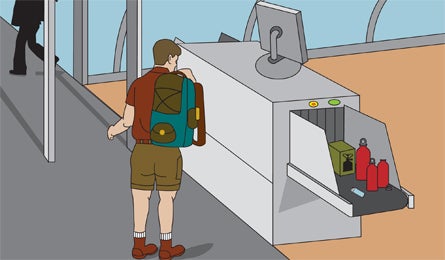Stoves on a Plane

'Illustration by Jackie McCaffrey'
You’re about to board a flight to Montana for a week-long trek when you’re pulled out of line to explain your trusty white-gas burner. “This scenario happens more often than we like,” says Dennis Juenemann, a FAA Hazardous Materials Specialist based in Ft. Worth, TX. Since backpacking gear can run afoul of multiple safety rules, he recommends hikers be cautious and follow these strategies for hassle-free travel.
Stoves
Only new stoves in their original packaging are always allowed. Used stoves must be cleaned of all burn deposits and odors to pass inspection. Liquid-fuel stoves are refused more often than canister burners because they retain more residue, says Juenemann. Scrub stoves thoroughly with soapy water, and pack them in checked luggage. To avoid trouble, BACKPACKER editors mail stoves and fuel bottles to outdoor stores at their destination.
Fuel
Like stoves, brand-new and empty liquid fuel bottles are okay, but used containers must be completely cleaned out. “If there’s any kind of fuel smell, it hasn’t been purged,” says Juenemann. Pack them uncapped and easily accessible in your checked luggage. Full bottles and gas canisters are forbidden.
Lighters
As of August 2007, you can pack butane lighters in carry-on luggage, along with one book of safety matches. Both items are prohibited in checked baggage.
Batteries
Alkaline, NiMH, and NiCad types are fine, but passengers cannot pack spare lithium metal batteries (used in many cameras and GPS units) in checked luggage. Put them in your carry-on bag.
Liquids
Bear sprays exceed the 4-fluid-ounce limit established by the TSA for self-defense sprays in checked baggage. Ship it ahead of time, or buy it at your destination.